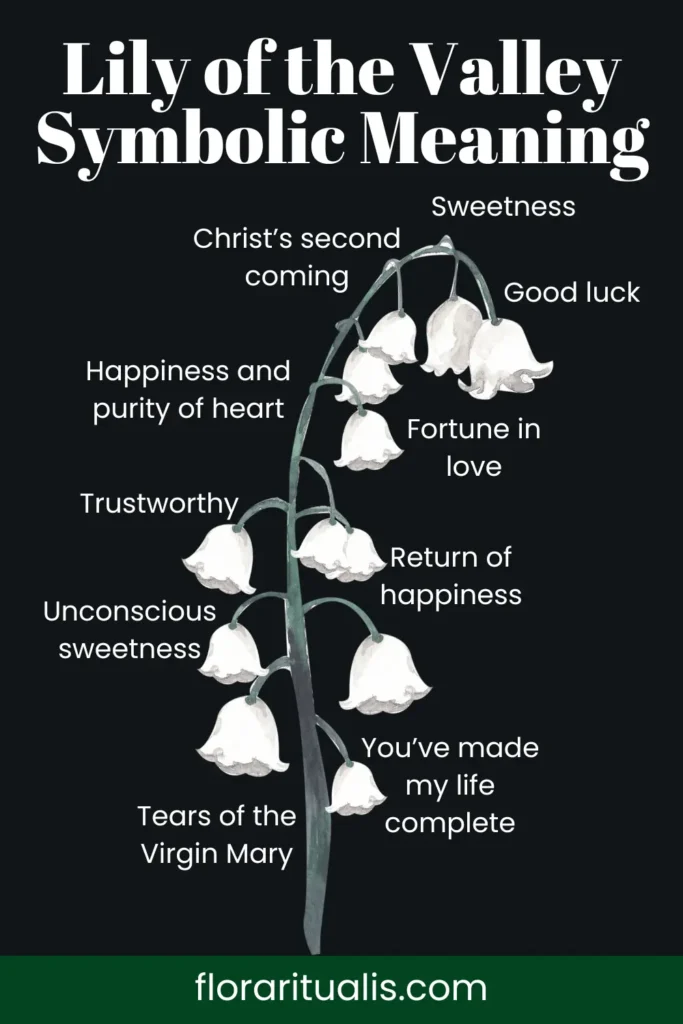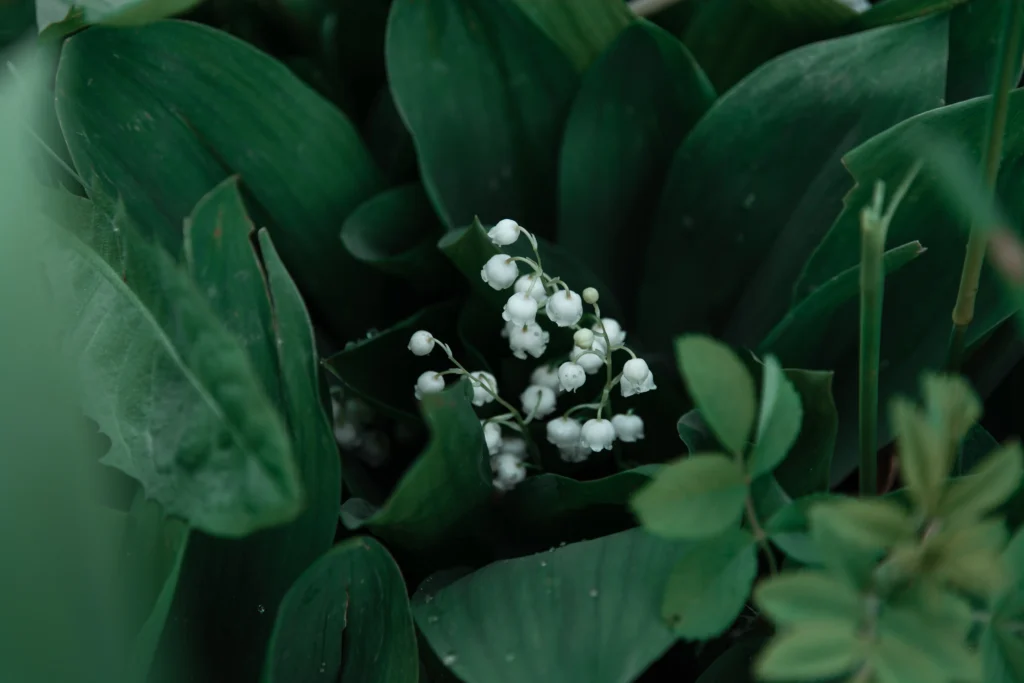The Lily of the Valley meaning comes from its uses in history, the legends and myths associated with the flower.
It is also commonly called Convall Lily, Jacob’s Ladder, May lily, Muguet or Ladder to Heaven.
The plant is indigenous to the Eurasian climates moreover, they are also believed to have originated in Japan.
In this blog we will explore the meaning of the lily of the valley. We will then get into the different facts the surround the flower, its history and mythology.
Lets get right into it.
What does Lily of the Valley symbolise?
The Lily of the Valley symbolises happiness and purity of heart, Christ’s second coming, fortune in love, unconscious sweetness, you’ve made my life complete, Return of happiness and the Tears of the Virgin Mary.
Its possible powers are mental clarity, power of the people to visualise a better world and healing. The flower comes under the dominion of the planet Mercury.
Lily of the valley birth flower meaning
The Lily of the Valley comes under the dominion of the planet Mercury. This makes it a perfect birth flower for the Gemini and Virgo zodiac signs since both zodiacs are ruled by Mercury.
The sign of Virgo is often known as the virgin in astrology. Moreover, it also links to the mother archetype and wheat. This is an allusion to nurturing mother earth that sustains life.
I believe that the Lily of the Valley make an even better fit for Virgo natives because of its close association to mother Mary and the mother archetype in general.
Lily of the Valley facts
- The Lily of the Valley grows in the wild across various European countries. However, the plant is more abundant in the cooler northern parts of Europe.
- During ancient times the flower was thought to be special to the Norse goddess Ostara.
- The botanical name of the plant Convallaria Majalis comes from the Latin word “valley.”
- Placing Lily of the Valley in a room was said to uplift and cheer of the people in it.
- The plant was used to improve the memory and minds of people.
- The Lily of the Valley shared a common name across France and Italy. Muguet in French and Mughetto in Italian both derives the word muge which translates to musky or heady scent. The French still celebrate May Day or Fête du Muguet.
- King Charles IX was given a Lily of the Valley as a good luck charm. He became so enamoured with the perfume of the flower that he decided to give a flower to all the ladies in the court. This is perhaps what also inspired French people to pursue this good luck ritual.
- Germans also have a similar ritual with Maiglöckchen (Little May bells) on Whit Monday.
- The Lily of the Valley is the national flower of Finland, there it is called kielo which translates to ‘tongue’ as an allusion to its leaves.

Lily of the Valley Greek mythology
In Greek mythology it was believed that the Lily of the Valley was found by Apollo and he gave it to Aesculapius for its medicinal properties.
When the flower was distilled in water it was believed to have a great curative effect and was therefore called Aqua Aurea (Golden Water). The water was kept in vessels of gold and silver.
As the official flower of May, the lily of the valley is also connected to the goddess Maia.
Maia is the eldest of the seven sister (the Pleiades constellation). Maia rules over spring and fertility. She is also the mother of the god Hermes (Greek equivalent of Mercury).
Lily of the Valley History
During the Mediaeval period, monks and nuns believed that the Convallaria was the Lily of the Valley.
They believed that it was the flower mentioned in the Canticles and also the flower that Christ alluded to when he bade his disciples to consider the Lilies of the field.
However, now the Lily of the field is thought to be Martagon Lily which is considered as the Lily of Palestine.
The Lily of the Valley is also commonly referred to as Virgin’s tears. Moreover, they are the flowers that are dedicated to Whitsuntide. In England, they have also retained their old name of May Lilies in several place.
There was a superstition that existed in the region of Devon. If someone planted a bed of Lilies of the Valley then they would die within the next twelve months. Therefore, they considered the plant as unlucky.
In the region of Sussex there was a legend associated with the Lily of the Valley. The legend retells that there was once a holy man called St Leonard and he lived deep in the forest.
He had to share the forest with a terrible dragon called Temptation. The holy man and the dragon would always fight. One day St Leonard would manage to drive the beast away, however, he would also get injured in the process. It was said wherever his blood fell on the ground there would be a Lily of Valley growing.
The flower is also commonly called “Lady’s Tears” this came from the idea that the flowers sprang from where Mary wept for Jesus at his crucifixion.

Lily of the valley uses
‘Glovewort’ was an unusual name for the Lily of the Valley. However, they were mentioned in the Leechdoms, Wortcunning and Starcraft of Early England.
They were prescribed as a balm which would help to remove wort from the hands. Moreover, another treatment using the Lily of the Valley was for arthritis.
Lily of the Valley Victorian meaning
In the language of flower the Lily of the Valley represent “return of happiness.” This was due the month of May. The flowers would be at its peak. It would also herald the transition from spring into summer.
During Whit Monday, Victorians would take off to local woods in order to gather Lily of Valley. This would then be proceeded by dancing and refreshments.
Moreover, in Cornwall they would participate in a spring festival called Furry or Flora Dance. They would wear the Lily of the Valley as a sprig on the gentleman’s lapel or upside down on the lady’s dress.
The flowers also commonly featured on greeting postcards. They would also feature on playing cards accompanied by other wild flowers.

If you liked this blog don’t miss out on our other blogs on flowers under the dominion of planet Mercury.
References
Dietz, S. T. (2022). The complete language of flowers the complete language of flowers: A definitive and illustrated history – pocket edition. Wellfleet Press.
Ferguson, G. (1966). Signs and symbols in Christian art: With illustrations from paintings of the renaissance. Oxford University Press.
Olick, L. (2013). Witchy crafts: 60 Enchanted projects for the creative witch. Llewellyn Publications. https://books.google.at/books?id=olTSJyOzSkMC
Rhind, J. P. (2013). Fragrance and wellbeing: Plant aromatics and their influence on the psyche. Singing Dragon. https://books.google.at/books?id=LamNAQAAQBAJ
Silverthorne, E. (2003). Legends and lore of Texas wildflowers. Texas A & M University Press.
Thiselton Dyer, T. F. (1994). Folklore of Plants. Llanerch Press.
Watts, D., & Watts, D. C. (2007). Dictionary of Plant Lore. Academic Press.
Deena Bsingh, a UK-born, Mauritius-raised content writer, is a dedicated explorer of the ancient world’s hidden treasures. Armed with classical studies knowledge and a decade of spiritual immersion, Deena delves deep into the wellspring of ancient wisdom. Her illuminating writings on flower meanings and culinary history are imbued with the profound insights she has gathered on her journey. Through her Medium articles, she guides readers on transformative journeys that bridge the gap between ancient cultures and contemporary consciousness, offering a rich tapestry of understanding that endures through time.

